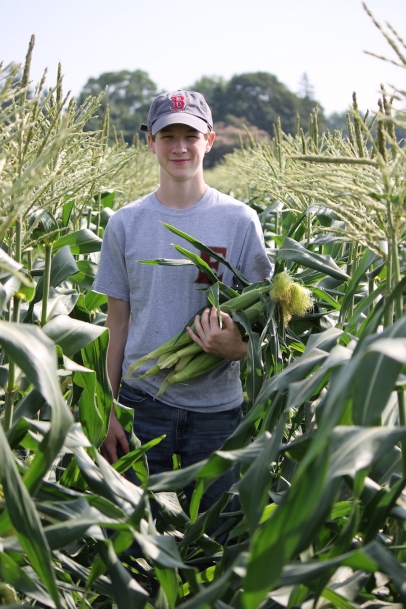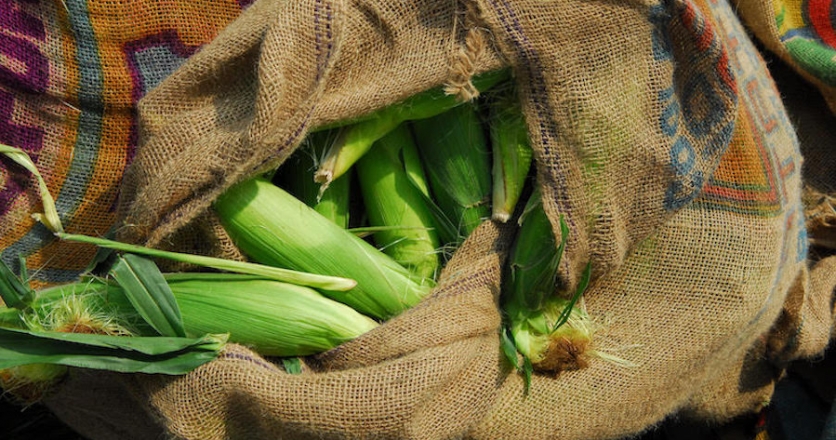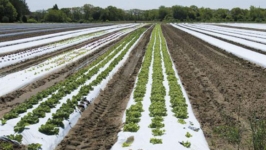Summers on the Farm
Zucchini, rhubarb and lettuce mark the path. I have grown up living right next to a farm and I love our unique neighborhood where “the neighbors” are constantly rotating with the change of every season. Spring welcomes the plowed fields and little glimpses of green to build anticipation. Summer brings visitors of all ages who come to pick baskets full of strawberries, cut colorful flowers and shop for fruits and vegetables of all sizes, shapes and colors.
As the summer comes to its end, I look out my window at my “neighbors.” The corn stands tall, watermelons canvas the ground and tomatoes paint the rows red. Then, as the days grow shorter and I look up from my computer, I have a whole new set of neighbors: Sweet oats fill the first rows, majestic kale looms over the delicate carrot greens and Brussels sprouts pop off their stalks happily. Living adjacent to a farm has a kind of magic to it.
I worked for four summers as a farm hand at Four Town Farm, a 150-acre family-owned crop farm that grows a variety of fruits and vegetables. As a child, I believed my doctor and surgeon father worked the longest hours of anyone—in fact, I sometime wondered if he ever slept. Then, once I began to work at the farm, I learned how many hours in the day a farmer works. These men and women are on their tractors when the sun comes up, and they are on their tractors long after the sun has set. Farmers work hard!
I witnessed firsthand the intricate planning involved in the gradual creation of one full-grown plant going from fragile seed to dinner plate. There are many pieces to this amazingly thoughtful process, all of which require a farmer’s full attention.
Tilling
The ground needs preparation for the variety of plants that eventually get seeded, so tearing up the soil and replacing it helps the growth of these crops. Tilling can be done either with a simple handheld shovel digging up the dirt, which I was allowed to do, or by enormous John Deere tractors with sinister looking attachments, which I most likely will never be allowed to do.
Transplanting
The seemingly endless rows of soil are the hosts for the tiny soon-to-arrive sprouts that have been cultivated in trapezoidal cubes of dirt and roots, then lined up and ready for planting. For home gardens, fledgling plants would simply need a firm push into the ground with a little cover dirt to seal the deal. At Four Town Farm, I sat on one of four low-rise seats hooked on the back of an immense tractor where a six-holed circle made of metal pins hovered in front of me. I gently placed the seedlings in a beak-like apparatus where the bottoms of the holes opened and closed so that each plant fell into the machine-made pockets in the soil and the previously dug hole got covered up, all in a rhythmic process.
Weeding
In my first year working on the farm I was ordered to hoe the strawberry fields, all alone, more than a few times. I figured this was an unnecessary runt job that no one else was willing to do. After a few hours of sweat-drenching work, I’d catch myself rambling on to the plants about nothing in particular, just to pass the time. In the ensuing years I realized the importance of simple jobs such as this. Every weed like lamb’s quarter, purslane or smartweed is a danger to the nearest crop. With the capability of mimicking the very plants from which it drains nutrients, smartweed masks itself to look almost identical to the crop. While usually tedious, weeding is also a job that comes with a sense of accomplishment when seeing the “messy” fields turn into beautifully “clean” rows. Small or large, all crops need to be kept safe from creeping weeds.
Patience
Almost as un-exciting as weeding is the necessity for patience. Crops do not grow in front of our eyes; they grow at their own pace, and the farmer must allow them time to grow. Along with this patience comes faith. With a few aids such as anti-bird balloons, honking cars and raucous noisemakers that scare away greedy crows and vermin, the crops follow their natural course.
The Harvest
Time passes and, finally, the crops are ready to be picked and harvested. The most daunting job by far is the fast-paced race of picking corn before the sun reaches its peak. As I walk backwards through leaves that are drenched from watering, I take one careful step after the next, making sure not to trip over the fallen stalks. I must keep up with the three men in front of me. Pulling six ears at a time, the burlap sack fills up quickly. I count the bunches up to 10. Then, leaning the bulging container against the corn, I methodically reach in and grab another sack to fill. This process of picking is stressful, but the job gets done in the fastest manner possible.
Consumption
On Four Town Farm the freshly picked produce is transported one of three ways. The first is to sort the produce into boxes to be moved and stored in the refrigerators for later shipments. The second is to package and give to local farmers markets and supermarkets in bulk amounts. The third and final ending for the farm produce is to send it straight to Four Town Farm’s own farm stand. Needless to say, this is the option I like best. My family eats fresh corn every day from the first picked crop sometime in July all the way through November; we eat it any way we can: grilled, boiled, steamed, hot, cold, buttered or peppered!
Rest
At 9:30 am each morning, I hear, “A’ight! Coffee time!”
My boss shouts down from his 12-foot high John Deere behemoth. Like the machine, we all stop what we are doing and make our way to the pickups at the edge of the field. The Guatemalan farmers with whom I work alongside laugh at jokes they tell in Spanish; even though they know I don’t really understand, they include me in their fun. It is during “coffee time” I see the true power of the process. With the entire workforce of only 18 gathered in one small area, eating, sipping, laughing and resting, I look out at the fields and am awed at how much can get done when so few people are all part of a bigger process.









